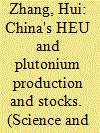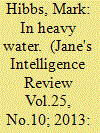| Srl | Item |
| 1 |
ID:
104162


|
|
|
|
|
| Publication |
2011.
|
| Summary/Abstract |
This article discusses the history of China's production of highly enriched uranium and plutonium for nuclear weapons and uses new public information to estimate the amount of highly enriched uranium and plutonium China produced at its two gaseous diffusion plants and two plutonium production complexes. The new estimates in this article are that China produced 20 ± 4 tons of HEU, 2 ± 0.5 tons of plutonium, and currently has stockpiles of about 16 ± 4 tons of HEU and 1.8 ± 0.5 tons of plutonium available for weapons. The values for China's fissile material production are at the low end of most previous independent estimates, which range from 17-26 tons of highly enriched uranium and 2.1-6.6 tons of plutonium. These new estimates would be significant to assess China's willingness to join a fissile material cutoff treaty and a multilateral nuclear disarmament.
|
|
|
|
|
|
|
|
|
|
|
|
|
|
|
|
| 2 |
ID:
115970


|
|
|
|
|
| Publication |
2012.
|
| Summary/Abstract |
This article assesses the feasibility and benefits of converting the Iranian heavy water research reactor, IR-40, from using natural uranium to low-enriched uranium fuel. Based on neutronics calculations for a detailed model of the two reactor configurations, a conversion would result in a smaller core with a subsequent reduction and degradation of plutonium production. It is argued that the proposed conversion will provide Iran with a research reactor that is better suited for scientific experiments and radioisotope production than in its original configuration. It is proposed to introduce the converted IR-40's fuel consumption requirements as a natural cap for Iran's future enrichment efforts.
|
|
|
|
|
|
|
|
|
|
|
|
|
|
|
|
| 3 |
ID:
125616


|
|
|
|
|
| Publication |
2013.
|
| Summary/Abstract |
After 10 years of design procurement, and construction, Iran's new heavy water reactor in Arak is nearing completion. Mark Hibbs explains why the project is a growing concern for those monitoring Iran's nuclear capabilities.
|
|
|
|
|
|
|
|
|
|
|
|
|
|
|
|
| 4 |
ID:
106336


|
|
|
|
|
| Publication |
2011.
|
| Summary/Abstract |
The graphite isotope ratio method can give an accurate estimate of the total plutonium production in a graphite-moderated reactor without detailed information on the reactor's operating history. Transmutation of trace impurities in the graphite is directly related to the cumulative plutonium production in the nuclear fuel. This study explains how the total amount of plutonium produced in the five megawatt electric graphite reactor at Yongbyon could be estimated using the Graphite Isotope Ratio Method (GIRM) technique once a number of strategically located samples from the graphite moderator are available.
|
|
|
|
|
|
|
|
|
|
|
|
|
|
|
|
| 5 |
ID:
080443


|
|
|
|
|
| Publication |
2007.
|
| Summary/Abstract |
India is building a 500 MWe Prototype Fast Breeder Reactor, which is scheduled to be operational by 2010. India has refused to accept international safeguards on this facility, raising concerns that the plutonium produced in its uranium blankets might be used to make nuclear weapons. Based on neutronics calculations for a detailed three-dimensional model of the reactor, we estimate that up to 140 kg of weapon-grade plutonium could be produced with this facility each year. This article shows how India's large stockpile of separated reactor-grade plutonium from its unsafeguarded spent heavy-water reactor fuel could serve as makeup fuel to allow such diversion of the weapon-grade plutonium from the blankets of the fast breeder reactor. We describe and assess the most plausible refueling strategies for producing weapon-grade plutonium in this way.
|
|
|
|
|
|
|
|
|
|
|
|
|
|
|
|